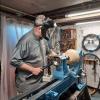This is one of the roughs I've been looking forward to turning. No tungsten this time, other than ambient overheads. The colors are a little richer in the photos than in real life, but the wood is what I hoped for.
IMG_5004.jpgIMG_5011.jpgIMG_5015.jpg
IMG_5016.jpgIMG_5017.jpgIMG_5018.jpg
About 7-1/2"x2-1/4", Watco DO, Minwax WOP, waxed and buffed. Comments always.





 Reply With Quote
Reply With Quote



